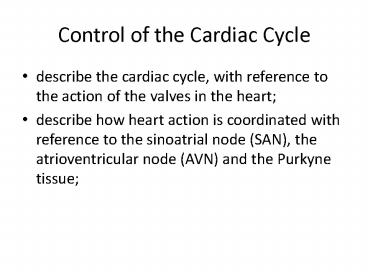Control of the Cardiac Cycle PowerPoint PPT Presentation
Title: Control of the Cardiac Cycle
1
Control of the Cardiac Cycle
- describe the cardiac cycle, with reference to the
action of the valves in the heart - describe how heart action is coordinated with
reference to the sinoatrial node (SAN), the
atrioventricular node (AVN) and the Purkyne
tissue
2
Control of the Cardiac Cycle
- describe the cardiac cycle, with reference to the
action of the valves in the heart - describe how heart action is coordinated with
reference to the sinoatrial node (SAN), the
atrioventricular node (AVN) and the Purkyne
tissue
3
The Need for Co-ordination
- Heart (cardiac) muscle is unusual as it can
initiate its own contraction - This is known as myogenic
- The muscles can contract and relax rythmically
even if its not connected to the body - The muscles of the atria and ventricles have
their own natural frequency of contraction- the
atrial muscle has a higher frequency (number of
contractions) than the ventricular muscle - The property of the muscle could cause
inefficient pumping (fibrillation) if the
contractions are not synchronised- so the heart
needs a mechanism for control
4
(No Transcript)
5
The Need for Co-ordination
- At the top of the right atrium, near the point
where the vena cava empties blood into the
atrium, is the sino-atrial node (SAN) also known
as the pacemaker - This is a small patch of tissue that generates
electrical activity - The SAN initiates an excitation wave about 55-80
times a minute
Use p70 to summarise the role of the SAN and AVN
6
Contraction of the Atria
- The wave of excitation quickly spreads over the
walls of both atria - It travels along the membranes of the muscle
tissue and causes the cardiac muscles to contract - This is Atrial Systole
7
Contraction of the Atria
- At the base of the atria is a disc of tissue that
cannot conduct the excitation wave (electrical
wave) - This means the wave cannot spread directly to
the ventricles - At the top of the inter ventricular septum
(separating the two ventricles) is another node-
the atrio-ventricular node (or AVN) position 2 on
the diagram - This is the only route through the disc of
non-conducting tissue - The wave of excitation is delayed in the node,
this allows time for the atria to finish
contracting and for the blood to flow down into
the ventricles before they contract
1 SAN (pacemaker) 2 AVN
8
Contraction of the Ventricles
- After the delay the wave of excitation is carried
away from the AVN and down specialised conducting
tissue called the Purkyne tissue which runs down
the inter ventricular septum (position 3 on
diagram) - At the base of the septum the excitation wave
spreads out over the walls of the ventricles - As it spreads upwards from the base of the
ventricles, it causes the muscles to contract - This means that that ventricles contract from the
base upwards, pushing blood up to the major
arteries the aorta and the pulmonary artery
3 Bundle of His 4 5 Purkyne Tissue
9
(No Transcript)
10
ElectroCardiograms
- We can monitor the electrical activity of the
heart using an electrocardiogram or ECG - Sensors must be attached to the skin which pick
up the electrical signals from the heart - The trace of a healthy person has a particular
shape consisting of waves labelled P, Q, R, S and
T
- P shows the excitation of the atria
- QRS indicates excitation of the ventricles
- T shows diastole (relaxing)
11
(No Transcript)
12
The Shape of an ECG
- The shape of the ECG trace can sometimes be used
to show which part of the heart is unhealthy - It can show irregular heart beat (arrhythmia) if
it is in fibrillation (the beat is not
co-ordinated), if it has suffered a heart attack
(myocardial infarction) - It can also indicate if the heart is enlarged or
if the Purkyne system is not conducting
electrical activity properly
A heart block is when there is a problem with the
electrical signals in the heart
13
Now try SAQ 6 on p71
14
(No Transcript)
15
20 boxes
In 1 second, 25 boxes travel past the machine One
box travels at 1 second/25 boxes 0.04 seconds
per box One heart beat lasts for approximately 20
boxes 20 boxes x 0.04 seconds per box 0.8
seconds for each heart beat How many 0.8 seconds
are in 1 minute? 60 seconds / 0.8 seconds 75
beats per minute
16
(No Transcript)
17
b (i) This is the time during which the
ventricles are contracting B (ii) In 1 second, 25
boxes travel past the machine One box travels at
1 second/25 boxes 0.04 seconds per
box Contraction time (Q-T) lasts for
approximately 7 boxes 7 boxes x 0.04 seconds per
box 0.28 seconds for each contraction time
18
(No Transcript)
19
b (i) This is the time during which the
ventricles are relaxed and filling with blood B
(ii) In 1 second, 25 boxes travel past the
machine One box travels at 1 second/25 boxes
0.04 seconds per box Contraction time (T-Q) lasts
for approximately 13 boxes 13 boxes x 0.04
seconds per box 0.52 seconds for each filling
time

